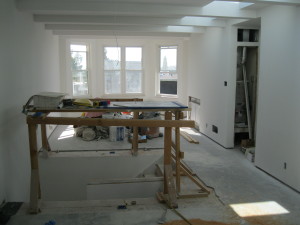My husband is the keeper of the house paints in our home. That’s because he does most of the painting–interior and exterior–himself. I asked him how he keeps track of all the half-used paint cans since we had just completed a small remodel project. His answer was quite simple. “Label each can as you seal it.” Here’s how:
Use a piece of masking or painter’s tape on the can lid. Include the room or area where it got used and the date.
The date is especially important, because if you’ve repainted the room a different color in the interim, you can get rid of that paint. Check with your local waste management service regarding proper disposal. Also, previously used paint does have a shelf life. Anywhere from 2-5 years. After that, it can get moldy or contain a foul odor. Ever try to tell the difference between Sherwin-Williams Swiss Coffee and Alabaster? Knowing which can of paint you used for which area of your home will prevent mistakes when you need a quick touch-up.






